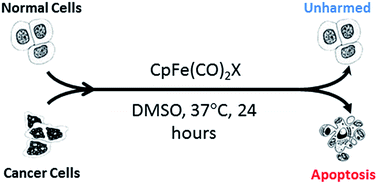Cyclopentadienyl iron dicarbonyl (CpFe(CO)2) derivatives as apoptosis-inducing agents†
Abstract
Iron has been found to serve multiple purposes besides being an oxygen carrier. Of particular note is the generation of deleterious free radicals which can lead to the formation of tumours. However, in this work, we have found that cyclopentadienyl iron carbonyl complexes CpFe(CO)2X (X = halide, NCS, BF4− and CpFe(CO)2) can induce apoptosis in breast cancer and HeLa cell lines. Normal cells are however unaffected. A detailed study on CpFe(CO)2I shows that the complex is metabolic-stable and easily permeable across a lipid barrier. Preliminary investigations into the mode of action suggest that a Fenton-type reaction caused by CpFe(CO)2 complexes may be related to cell death.


 Please wait while we load your content...
Please wait while we load your content...